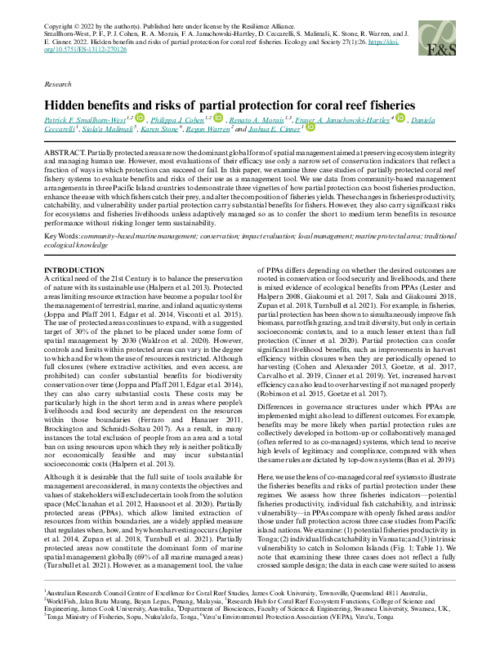Please use this identifier to cite or link to this item:
https://hdl.handle.net/20.500.12348/5133
Hidden benefits and risks of partial protection for coral reef fisheries
| dc.creator | Smallhorn-West, P. | en_US |
| dc.creator | Cohen, P.J. | en_US |
| dc.creator | Morais, R.A. | en_US |
| dc.creator | Januchowski-Hartley, F.A. | en_US |
| dc.creator | Ceccarelli, D.M. | en_US |
| dc.creator | Malimali, S. | en_US |
| dc.creator | Stone, K. | en_US |
| dc.creator | Warren, R. | en_US |
| dc.creator | Cinner, J. | en_US |
| dc.date.accessioned | 2022-04-04T20:50:52Z | |
| dc.date.available | 2022-04-04T20:50:52Z | |
| dc.date.issued | 2022 | en_US |
| dc.identifier.citation | Smallhorn-West, P. F. P. J. Cohen, R. A. Morais, F. A. Januchowski-Hartley, D. Ceccarelli, S. Malimali, K. Stone, R. Warren, and J. E. Cinner. 2022. Hidden benefits and risks of partial protection for coral reef fisheries. Ecology and Society 27(1): 26. https://doi.org/10.5751/ES-13112-270126 | en_US |
| dc.identifier.issn | 1708-3087 | en_US |
| dc.identifier.uri | https://hdl.handle.net/20.500.12348/5133 | |
| dc.description.abstract | Partially protected areas are now the dominant global form of spatial management aimed at preserving ecosystem integrity and managing human use. However, most evaluations of their efficacy use only a narrow set of conservation indicators that reflect a fraction of ways in which protection can succeed or fail. In this paper, we examine three case studies of partially protected coral reef fishery systems to evaluate benefits and risks of their use as a management tool. We use data from community-based management arrangements in three Pacific Island countries to demonstrate three vignettes of how partial protection can boost fisheries production, enhance the ease with which fishers catch their prey, and alter the composition of fisheries yields. These changes in fisheries productivity, catchability, and vulnerability under partial protection carry substantial benefits for fishers. However, they also carry significant risks for ecosystems and fisheries livelihoods unless adaptively managed so as to confer the short to medium term benefits in resource performance without risking longer term sustainability. | en_US |
| dc.format | en_US | |
| dc.language | en | en_US |
| dc.publisher | Resilience Alliance | en_US |
| dc.rights | CC-BY-4.0 | en_US |
| dc.source | Ecology and Society;27,(2022) | en_US |
| dc.subject | conservation | en_US |
| dc.subject | impact evaluation | en_US |
| dc.subject | community-based marine management | en_US |
| dc.subject | local management | en_US |
| dc.subject | marine protected area | en_US |
| dc.subject | traditional ecological knowledge | en_US |
| dc.title | Hidden benefits and risks of partial protection for coral reef fisheries | en_US |
| dc.type | Journal Article | en_US |
| cg.contributor.crp | Fish | en_US |
| cg.contributor.funder | Australian Center for International Agricultural Research | en_US |
| cg.coverage.country | Solomon Islands | en_US |
| cg.coverage.country | Vanuatu | en_US |
| cg.coverage.country | Tonga | en_US |
| cg.coverage.region | Melanesia | en_US |
| cg.coverage.region | Polynesia | en_US |
| cg.subject.agrovoc | Fish | en_US |
| cg.contributor.affiliation | WorldFish | en_US |
| cg.contributor.affiliation | James Cook University, ARC Centre of Excellence for Coral Reef Studies | en_US |
| cg.contributor.affiliation | James Cook University | en_US |
| cg.contributor.affiliation | James Cook University, College of Science and Engineering | en_US |
| cg.identifier.status | Open access | en_US |
| cg.identifier.ISIindexed | ISI indexed | en_US |
| cg.contribution.worldfishauthor | Smallhorn-West, P. | en_US |
| cg.contribution.worldfishauthor | Cohen, P.J. | en_US |
| cg.contribution.worldfishauthor | Warren, R. | en_US |
| cg.description.theme | Resilient small-scale fisheries | en_US |
| dc.identifier.doi | https://dx.doi.org/10.5751/ES-13112-270126 | en_US |
| cg.creator.id | Patrick Smallhorn-West: 0000-0001-6782-3704 | en_US |
| cg.creator.id | Philippa Jane Cohen: 0000-0002-9987-1943 | en_US |
